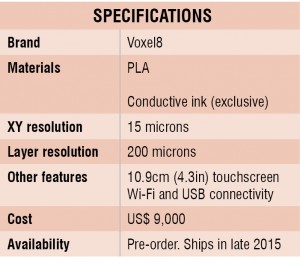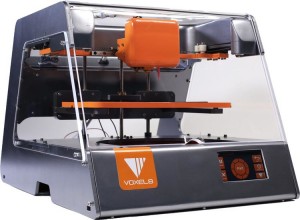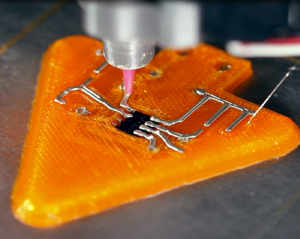A 3D printer that can print the plastic casing and internal connections, and lets you embed electronic components into it – this is now possible with the Voxel8 3D electronics printer.
By Anagha P
3D printing enthusiasts across the world have been looking forward to electronics printers.

In the 3D printer buyer’s guide dated March 2014, Carine Carmy, director of marketing at Shapeways 3D Printing Marketplace and Community was quoted as saying, “In the future, we are going to start to see mixed materials, electronics 3D printing and conductive materials as well.” But then we had not imagined this would become a reality within a year!
Electronics printers are here… almost
One of the interesting events at the Consumer Electronics Show (CES) 2015 was the launch of the pre-order campaign of Voxel8, which is claimed to be the first 3D electronics printer. Developed by the Lewis Research Group at Harvard, under the guidance of Dr Jennifer A. Lewis, Voxel8 lets users blend the plastic 3D printing material, an exclusive conductive paste and other electronic components into the same system to create highly-customisable objects from a simple antenna to a quadcopter.
The lab currently owns 17 patents (10 issued) on functional materials, print heads and other processes for 3D printing.

How it works
The Voxel8 3D printer uses traditional fused deposition modelling (FDM)/fused filament fabrication (FFF) technology along with conductive paste extrusion. It has two extruders (also known as print heads). One of the print heads is the traditional FDM head that is seen in all 3D printers and it extrudes polylactic acid (PLA). What makes this product special is the second print head that extrudes a special conductive ink made of highly-conductive silver particles developed at the Lewis Research Group lab at Harvard University. Also, the ink dries in about five minutes and can interconnect thin quad flat pack (TQFP) integrated circuits.

Embedding components: The printer also lets you insert or embed external electroniccomponents such as integrated chips, resistors and capacitors into the design while it is being printed, and the printing process continues after this is done. This was achieved by partnering with Autodesk to create a specialised software that is hosted in the cloud and lets the user design their product in 3D, where they can drag and drop electronic components, and add wires and connections to it. During the printing process, the device leaves a void where the respective components are to be placed and pauses at predetermined places where the components need to be embedded. The user can remove the print platform or print bed from the device, insert the component and place it back; and the printing process continues from where it was paused. Kinematic coupling and magnets are used to precisely fix the platform back in its exact place, when it is returned after manual embedding of components.
Only for rigid electronics
Voxel8 is not without its drawbacks. One of them is that it can be used only to print rigid electronics and not flexible ones. With flexible electronics gaining much popularity in the industry, it is time we moved on to another printing technology. Two firms are already working on printing flexible electronics using inkjet printers.
Another issue we find is that it supports just two materials – PLA plastic and conductive silver ink. However, the team has hinted at more functionalities and materials being introduced in the future. This promises a lot of opportunities for electronics enthusiasts!
The author is a dancer, karaoke aficionado, and a technical correspondent at EFY. Find her on Twitter @AnuBomb.










